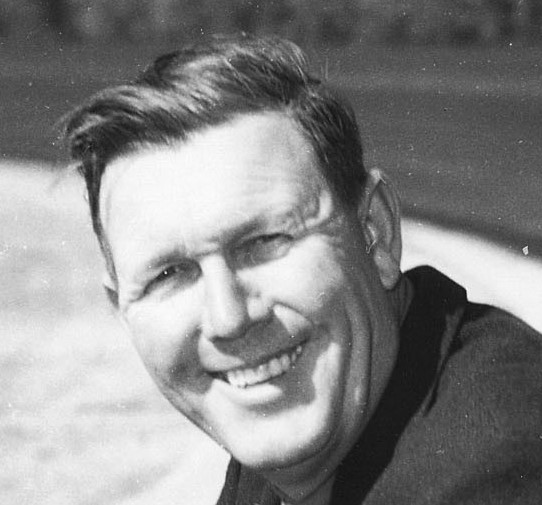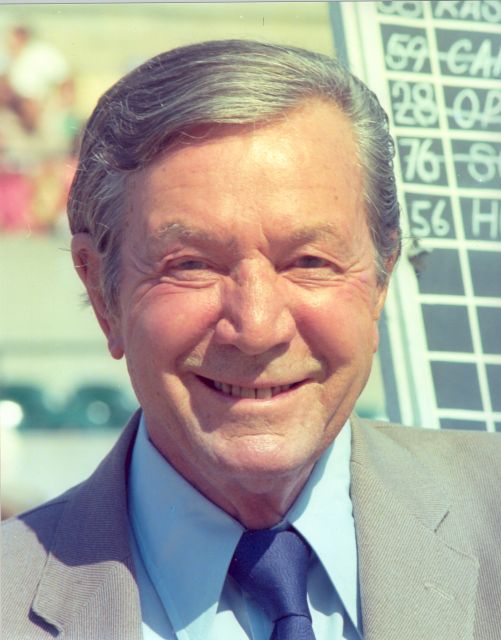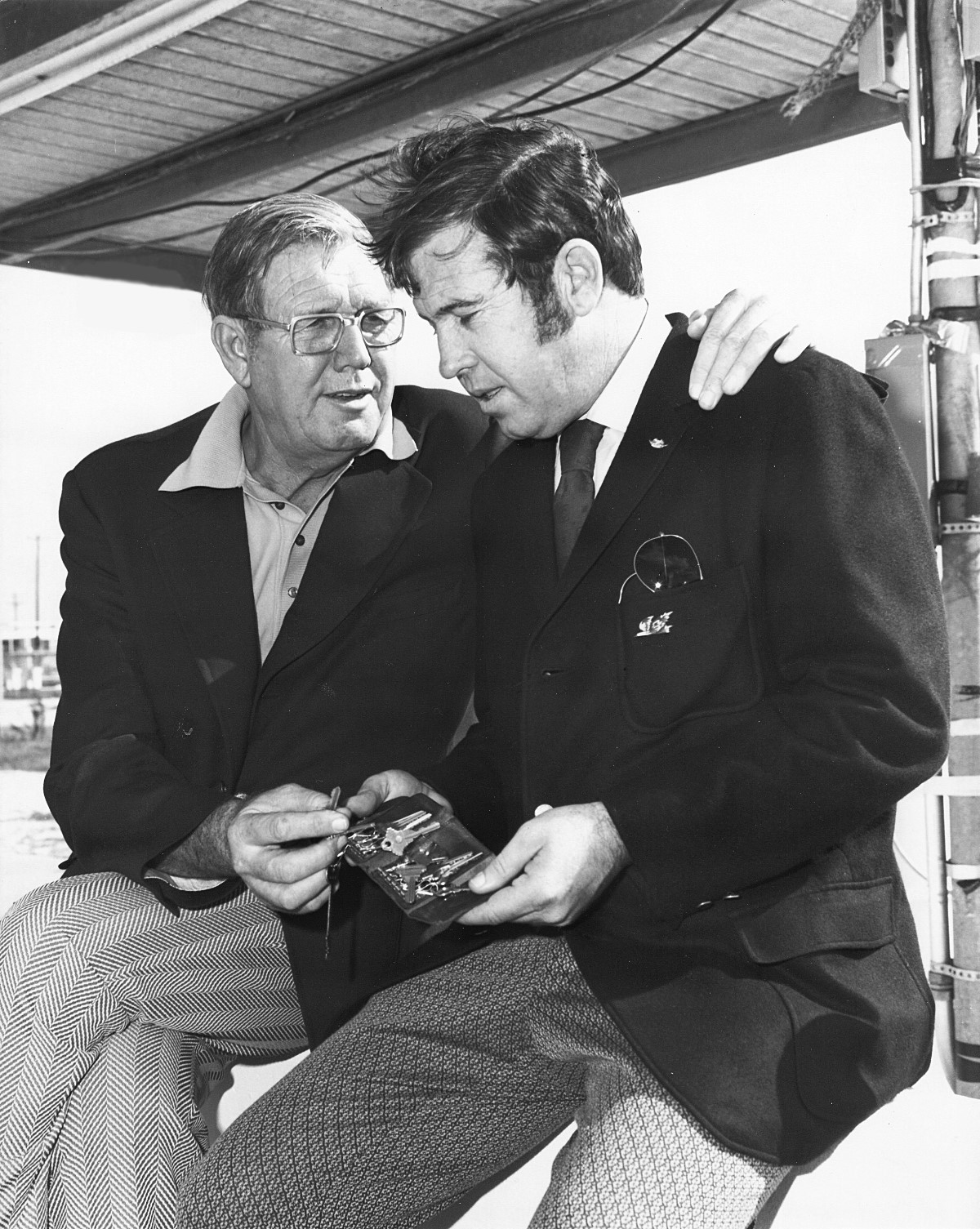It’s time that IMS give NASCAR the old heave-ho
 |
| Bill France Sr. |
“Kick him out," were the words Indianapolis Motor Speedway chief steward Harry McQuinn told one of his underlings on May 13, 1954. McQuinn, of course, had become alerted to the fact Bill France Sr., the legendary founder and president of NASCAR was spotted snooping around Gasoline Alley. Within minutes France was informed that his presence was no longer welcome at the Mecca of open-wheel racing, and as Indy 500 historian Donald Davidson, once said, “he was given the old heave-ho."
When asked for his reasoning in removing France from the grounds, McQuinn was rather forward with National Speed Sport News. “We have a longstanding disagreement with NASCAR on what constitutes good racing," he said.
Whether unable, unwilling, or a little both, NASCAR and Indy Car never really ironed out their grievances. Instead, both became territorial, going to great lengths to protect their hallowed plots of land.
 |
| Tony Hulman would never let NASCAR race at the Indy Speedway |
In fact, dating back to the 1950s, both organizations regularly suspended drivers who competed in the other’s events. While Speedway Savior Tony Hulman, was less punitive, it was a widely known fact he vehemently opposed a NASCAR event at the Speedway. His daughter Mari Hulman George would later fired then-IMS President John Cooper, a longtime NASCAR executive, when he wanted to bring NASCAR to the Speedway.
Overall, from the 1950s-1980s, the two charted their own distinct paths, experiencing differing degrees of success. All of that changed however in the early 1990s.
As NASCAR was beginning to grow from a regional phenomenon with humble roots, to a mainstream domestic sport entertainment entity, there were simultaneous changes for IMS. In 1989, Hulman’s grandson, Anton “Tony" Hulman George replaced the deceased Joe Cloutier as IMS boss.
George, who had no noteworthy resume of accomplishment, prior to ascending the IMS throne, immediately began to express his dissatisfaction with the powers to be in Indy Car racing, particularly the direction of CART, then the dominant sanctioning group. George believed CART was controlled by too many rich owners, and wanted greater say within the sport.
 |
| Bill France Sr. (left) taught Bill France Jr. (right) well. Junior would later go on to play Tony George like a fiddle |
In contrast to his dissatisfaction with CART, George found an usual confidant in Bill France, Jr., who succeeded his legendary father as tsar of NASCAR. George marveled at France’s unquestioned authority within NASCAR and sought to earn a similar status for himself within Indy Car.
On March 11, 1994, George would announce the formation of his own Indy car style series, the Indy Racing League, to begin competition in 1996.
Further, the son of NASCAR’s pioneering visionary would succeed in one area his father did not. Partnering with George in a variety of ways, France changed racing history forever when on August 6, 1994, NASCAR ran the inaugural Brickyard 400.
That day, before a capacity crowd at the famed Indianapolis Motor Speedway, a then young, former open wheel-standout Jeff Gordon, who had famously been rebuffed by the Indy car establishment, took a very popular victory in inaugural NASCAR Brickyard 400. The late Dale Earnhardt, Sr. would take victory the next year, while NASCAR legends such as Dale Jarrett, Jimmie Johnson, Tony Stewart and Bill Elliott would add their names to the scroll of Brickyard winners. An unholy alliance was born.
And for many years, the capacity crowds continued flocking to open-wheel racing’s Mecca at the corner of 16th and Georgetown, in Speedway, Indiana. While Hulman probably did somersaults in his grave and purists decried the abhorrent sight of cumbersome 3500-pound piles of sheet metal lumbering around the hallowed Speedway, the Brickyard made sense from a certain perspective. It was a boon for the local economy, a financial windfall for the Speedway, and marque event for NASCAR.
For his part, George continued to reinvest the proceeds in upgrading the Speedway's facilities and raising its profile on the racing scene. With an infield road course design, George would bring Formula One to IMS, for the United States Grand Prix from 2000-2007. Further, ill-fated as it was, the proceeds from the Speedway, assisted George in the civil war for control of Indy car racing,
In short, given the circumstances at the time, and assuming a certain point of view, the Brickyard made sense. IMS, NASCAR, and the city of Indianapolis all benefited financially.
However, in terms of Indy car racing’s overall place within the mainstream consciousness, the Brickyard never made one iota of sense. Further, when you consider that the enormous financial windfalls from the early capacity crowds went to propping up George’s ill-fated IRL, one must wonder if that was in fact, France’s plan all along.
Nevertheless, given the significant changes within the sport and to the event over the past 5 years, and the Brickyard’s recent diminished stature, the words of McQuinn about giving NASCAR the “old heave-ho," are more relevant now than ever.
To start, the notion of NASCAR’s eternal growth, has like many things in the past few years, been given a dose of reality. While NASCAR is still the unquestioned King of American motorsport, the series has endured consistent declines in attendance and television viewership for the past half decade.
Likewise, there have been changes galore on the Indy car front, most notably the fact Indy car racing is no longer a house divided. Yes, after a destructive decade and a half of damaging civil war, George, for better or worse, unified Indy car racing in 2008 under the IMS umbrella. Thus, the need for the Speedway aligning with NASCAR as a means of gaining leverage in an overall power struggle for Indy car racing, has ended.
Further, the Brickyard event has seen its profile diminish as well. A tire debacle in the 2008 race, and a layout that is not particularly conducive to stock cars, has earned the Brickyard a well-deserved reputation as something of a snoozer.
This past year, the race saw its worst attendance ever, estimated around 80,000 depending on the publication. And while I concede that the Brickyard undoubtedly made financial sense once upon a time, I don’t see how 80,000 people at IMS makes the Brickyard worthwhile.
Predictably, a lot of you will offer the profound answer, money. Yes, I’m aware the Brickyard makes money, even if the attendance is subpar. However, my question is whether the Brickyard is a wise decision relative to other options the Speedway has. For example, if IMS could draw 50,000 for an IndyCar Super Weekend on the road course, wouldn’t that make more sense than drawing 80,000 for NASCAR?
Sure, speaking strictly from a numbers standpoint, IMS would make more money by hosting NASCAR for the Brickyard. However, such thinking misses the big picture. While IMS certainly makes more money off the NASCAR event, they lose a potential opportunity to invest in, showcase, promote their own property, the Izod IndyCar Series. Instead, IMS welcomes their sport’s archenemy to their most sacred cathedral.
Sorry, but that doesn’t make a lot of sense to me.
Wouldn’t IMS rather pay a race purse to its cash strapped IndyCar teams, than to NASCAR teams? Wouldn’t IMS rather see purse money for support races go to Indy Lights and Star Mazda as opposed to Grand-Am and Nationwide? Wouldn’t IMS rather devote company time, energy, and resources to promoting an INDYCAR event, as opposed to a NASCAR event? Wouldn’t IMS rather see Dario Franchitti, Helio Castroneves and Ryan Hunter-Reay benefit from the local radio and television coverage promoting an event rather than Gordon, Tony Stewart and Jimmie Johnson? Wouldn’t IMS want to establish the Speedway, and the city of Indianapolis as exclusive ground, available only to its partners?
Now, some in the rah-rah motor racing media will goo and gush about the wonderful partnership between IMS and NASCAR, this is no partnership.
If the two were partners, NASCAR would maybe consider running a joint event with IndyCar on the racy Phoenix oval. If the two were partners, NASCAR would have never scheduled an event at a venue two weeks after the IndyCar events, as they recently did with a Nationwide race at Mid-Ohio. If NASCAR and IndyCar were partners, NASCAR would not have sabotaged with Champ Car’s ventures in Mexico and Canada years ago.
Of course, the IMS brass aren’t exactly known for being quick studies, and may just now be beginning to realize this. Further, I anticipate many of you will dismiss such a notion with the predictable and unoriginal rebuttals, often uttered by numerous mainstream media.
For example, you’ll probably mention that the cavernous Speedway would look empty on television with 50,000 people (as if racing before 5,000 people at Fontana is somehow better). You’ll definitely point out that the IMS road course layout is a dud (as if Long Beach and Toronto remind you of Spa.) You might also offer some nauseating diatribe about the sanctity of one IndyCar race a year at IMS.
To be fair, before the Freedom 100, Porsche Super Cup, MotoGP, Grand-Am, two NASCAR series, and whatever else, I may have listened to such an argument.. However, the second George invited the NASCAR to the sport’s most hallowed ground, any romantic notions of one race annually evaporated amidst the piercing sound of saloon cars circling the famed oval.
What you won’t point out is something that will in fact be a reasonable hurdle to such an event. This coming year, Crown Royal will be in the second year of a five-year deal to be the title sponsor of the Brickyard. While I am not privy to all the details, I can’t imagine said title sponsorship is simply transferrable to an IndyCar event.
Still, the Brickyard event is not doing INDYCAR any favors. Now, if the event was still drawing a quarter-million people, I might have a different take. I would interject my personal preference for an IndyCar event on the IMS road course. However, I would not be able to reasonably begrudge the Speedway such a financial windfall.
But all we’re talking about is a difference of about 30,000 people. For the difference in 30,000 attendees, IndyCar would get all the promotion, purse payout, and media coverage normally devoted to NASCAR. Further, IndyCar would establish itself once again as the premier show in its own market, denying NASCAR the platform it so craves.
In short, the Brickyard has become an antiquated dinosaur, that has long outlived its usefulness. It no longer serves the interests of IMS, nor the interests of its subsidiary property, INDYCAR.
The only interests the Brickyard continues to serve as those of the very family McQuinn wanted out of his paddock.
And while IndyCar’s return to glory is a long, uphill battle, that will arguably be decades in the making, I think an “old heave-ho," might be the perfect place to begin.
****The opening paragraphs were based on Bob Zeller’s fine 1994 work on NASCAR history in The Virginia-Pilot .
Brian Carroccio is an IndyCar columnist for AutoRacing1.com. He grew up around racing, as his father was a longtime SCCA crewman 1980s. At some point in the 1980s, Indy car racing became his first love, and Brian considers Al Unser, Sr., and Paul Tracy his favorite all-time drivers.
Brian lives in beautiful Rockville, MD. He is a diehard fan of the Washington Redskins, and considers Robert Griffin III something akin to a divine gift. He also roots for the Washington Nationals, Manchester United (kind of a long story) and Cal football (a really long story). You can follow him on Twitter @BrianC_AR1
